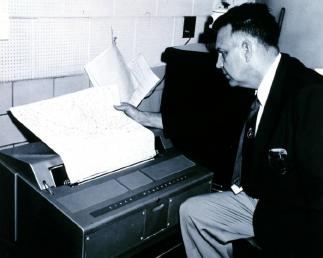POJ 3125 Printer Queue【简单模拟a打印队列】
来源:互联网 发布:哈萨克软件 kitaphana 编辑:程序博客网 时间:2024/04/30 14:36
经典的模拟队列题目
题目链接: http://poj.org/problem?id=3125
2012年8月7日,暑假组队后个人训练赛第一场
Printer Queue
Time Limit: 1000MS Memory Limit: 65536KTotal Submissions: 3082 Accepted: 1655
Description
 The only printer in the computer science students' union is experiencing an extremely heavy workload. Sometimes there are a hundred jobs in the printer queue and you may have to wait for hours to get a single page of output.
The only printer in the computer science students' union is experiencing an extremely heavy workload. Sometimes there are a hundred jobs in the printer queue and you may have to wait for hours to get a single page of output. Because some jobs are more important than others, the Hacker General has invented and implemented a simple priority system for the print job queue. Now, each job is assigned a priority between 1 and 9 (with 9 being the highest priority,
and 1 being the lowest), and the printer operates as follows.
- The first job J in queue is taken from the queue.
- If there is some job in the queue with a higher priority than job J, thenmove J to the end of the queue without printing it.
- Otherwise, print job J (and do not put it back in the queue).
Your problem with the new policy is that it has become quite tricky to determine when your print job will actually be completed. You decide to write a program to figure this out. The program will be given the current queue (as a list of priorities) as well as the position of your job in the queue, and must then calculate how long it will take until your job is printed, assuming that no additional jobs will be added to the queue. To simplifymatters, we assume that printing a job always takes exactly one minute, and that adding and removing jobs from the queue is instantaneous.
Input
One line with a positive integer: the number of test cases (at most 100). Then for each test case:
- One line with two integers n and m, where n is the number of jobs in the queue (1 ≤ n ≤ 100) and m is the position of your job (0 ≤ m ≤ n −1). The first position in the queue is number 0, the second is number 1, and so on.
- One linewith n integers in the range 1 to 9, giving the priorities of the jobs in the queue. The first integer gives the priority of the first job, the second integer the priority of the second job, and so on.
Output
For each test case, print one line with a single integer; the number of minutes until your job is completely printed, assuming that no additional print jobs will arrive.
Sample Input
31 054 21 2 3 46 01 1 9 1 1 1
Sample Output
125
Source
Northwestern Europe 2006
题意:
对于每组测试数据:
给你两个数 N , M
N代表当前打印机中的任务共有 N 个编号从 0 到 n-1 ,M表示你的任务所在的编号
下面每一行有 N 个数,代表各个任务的优先权.
PS:对于打印机,从前往后,优先权高的先打印。
如果当前任务排在第一位,而且它后面没有比它优先权更高的,那么直接打印,耗时为 1
如果当前任务排在第一位,只要它后面出现了比它优先权高的,那么就移动到队列尾部【移动不耗费时间】
问最后打印你的任务耗时多少
算法:
模拟队列
code:
去年的博客了,...
因为我现在还不会队列,所以就看的我学姐模拟的一个队列的代码:
/*思路(yf):这个题思路很简单,就是运用的队列,主要是处理时费时间。要想清楚才行,比如说,第一个,从队列的front 看来是找到rear,如是没有比他大的就直接打印,time +=1;判断这个点是不是标记的那个点,如果是,则直接输出time ,如果不是就向后走,还有需要注意的就是,如果是找到那个要打印的那个点,如果不能打印,那么这个标记打印的数也要跟着变化,主要就这两点吧代码:*/#include<iostream>#include<stdio.h>using namespace std;int main(){int a[10010];int front,rear,i;int cases,n,d,time,ok;scanf("%d",&cases);while(cases--){front=0;rear=0;time=0;ok=0;scanf("%d%d",&n,&d);for(i=0;i<n;i++){scanf("%d",&a[i]);rear++;}while(front<=rear){for(i=front;i<rear;i++){if(a[i]>a[front]) {a[rear++]=a[front];break;}}if(i>=rear) {time+=1;if(front==d){printf("%d\n",time);ok=1;break;}else front++;}else if(front==d) {d=rear-1;} else front++;if(ok) break;}}return 0;}- POJ 3125 Printer Queue【简单模拟a打印队列】
- POJ 3125 Printer Queue(打印队列---模拟)
- POJ 3125 Printer Queue 模拟队列
- uva 12100 Printer Queue(打印队列)模拟
- POJ 3125 && Sicily 1443 Printer Queue(模拟/队列)
- POJ 3125 && Sicily 1443 Printer Queue(模拟/队列)
- POJ 3125 Printer Queue(用队列模拟过程)
- Printer Queue打印队列
- 打印队列(Printer Queue)
- poj 3125 Printer Queue (队列)
- POJ 3125 Printer Queue 数据结构 队列
- UVa12100 Printer Queue (打印队列)
- UVA12100:Printer Queue(打印队列)
- poj 3125 Printer Queue
- POJ 3125 Printer Queue
- Printer Queue(poj 3125)
- poj 3125 Printer Queue
- POJ 3125 Printer Queue
- ax88180测试
- SAP BI版本介绍 (平台)
- TJU 2795 The Queen's New Necklaces(Polya+多重集排列)
- VC调用C#的COM组件(DLL)
- C++Simplify06-指针
- POJ 3125 Printer Queue【简单模拟a打印队列】
- 素数专题
- 使用struts2拦截器,对session失效的校验
- 引用与指针的比较
- PHP之AJAX编码问题
- 附件的WORD文档
- Mybatis各种模糊查询
- 高可用性的HDFS学习笔记1
- 堪称一绝的“IO口扫键”法


